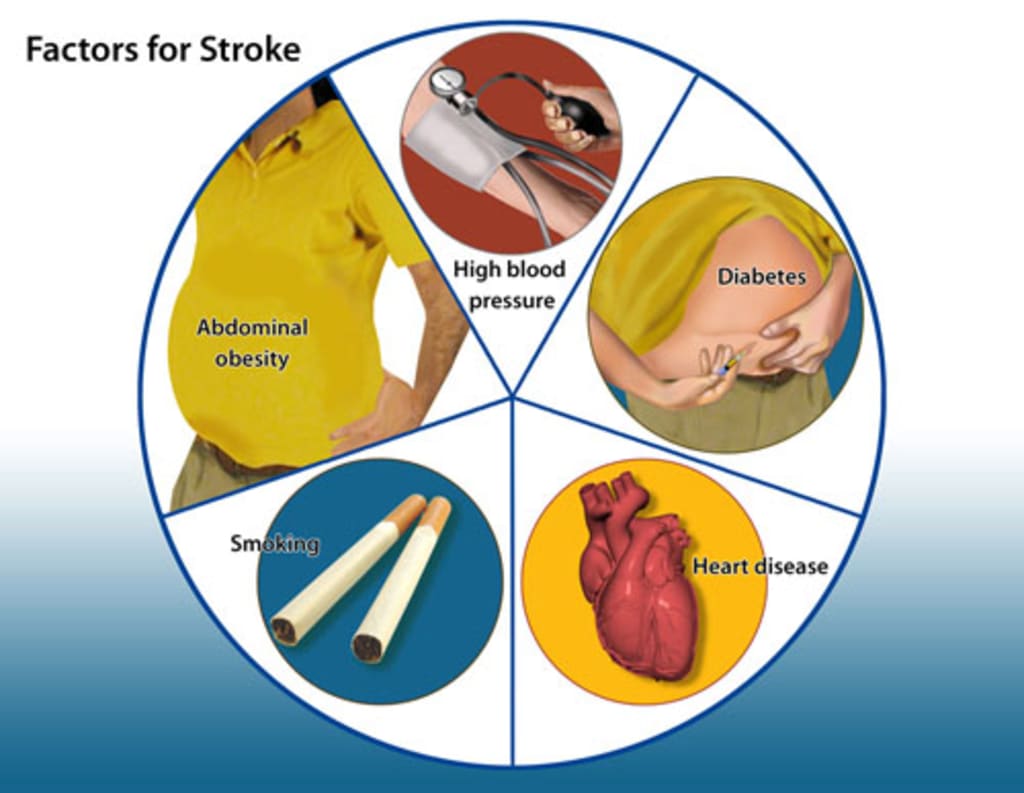Content warning
This story may contain sensitive material or discuss topics that some readers may find distressing. Reader discretion is advised. The views and opinions expressed in this story are those of the author and do not necessarily reflect the official policy or position of Vocal.
Who is at risk for strokes and how may they be prevented?
What You Need to Know About Stroke Risk Factors and Prevention

Strokes are a significant health concern that affects millions of people worldwide, causing disability, mortality, and a substantial economic burden. However, many strokes are preventable through targeted interventions and lifestyle modifications. By understanding the risk factors associated with strokes and implementing preventive measures, individuals can significantly reduce their chances of experiencing a stroke. In this article, we will explore the various risk factors for strokes and discuss effective strategies for stroke prevention.
Understanding Stroke
A stroke occurs when the blood supply to the brain is interrupted, either due to a blockage or the rupture of a blood vessel. This interruption deprives the brain cells of oxygen and nutrients, leading to cell death. Strokes can cause a wide range of symptoms, including sudden numbness or weakness, difficulty speaking or understanding speech, vision problems, dizziness, and severe headaches.
Identifying Stroke Risk Factors
While strokes can occur suddenly and unexpectedly, certain risk factors increase an individual's likelihood of experiencing a stroke. Some risk factors cannot be modified, such as age, family history, and ethnicity. However, there are several preventable risk factors that individuals can address to minimize their stroke risk.
1. High Blood Pressure (Hypertension)
High blood pressure is the leading cause of strokes. When blood pressure remains elevated over an extended period, it puts excessive strain on the blood vessels, making them more susceptible to damage or rupture. Managing blood pressure through regular monitoring, a healthy diet, regular exercise, and, if necessary, medication, can significantly reduce the risk of stroke.
2. Unhealthy Diet
A poor diet high in saturated fats, cholesterol, sodium, and sugar contributes to various risk factors for stroke. It can lead to obesity, high blood pressure, diabetes, and high cholesterol levels, all of which increase the likelihood of experiencing a stroke. Adopting a balanced diet rich in fruits, vegetables, whole grains, lean proteins, and healthy fats can promote cardiovascular health and reduce stroke risk.
3. Physical Inactivity
A sedentary lifestyle is associated with numerous health risks, including stroke. Regular physical activity helps maintain a healthy weight, lowers blood pressure, improves circulation, and enhances overall cardiovascular health. Engaging in moderate-intensity aerobic exercise, such as brisk walking, cycling, or swimming, for at least 150 minutes per week is recommended to reduce stroke risk.
4. Smoking and Tobacco Use
Smoking damages blood vessels, increases blood pressure, and raises the risk of blood clots, making it a significant risk factor for strokes. Additionally, exposure to secondhand smoke can also increase the chances of stroke. Quitting smoking and avoiding tobacco products can have a profound impact on reducing stroke risk and improving overall health.
5. Excessive Alcohol Consumption
Excessive alcohol consumption has been linked to an increased risk of stroke. Heavy drinking can elevate blood pressure, contribute to irregular heart rhythms, and promote the formation of blood clots. Moderation is key when it comes to alcohol consumption. It is generally recommended to limit alcohol intake to one drink per day for women and up to two drinks per day for men.
6. Obesity and Diabetes
Obesity and diabetes are both risk factors for stroke. Excess body weight can contribute to high blood pressure, high cholesterol, and diabetes, all of which increase the risk of stroke. Maintaining a healthy weight through a combination of a balanced diet and regular exercise is crucial for stroke prevention. Managing diabetes through proper medication, monitoring blood sugar levels, and adopting a healthy lifestyle also plays a significant role in reducing stroke risk.
Prevention Strategies
Now that we have identified the key risk factors for strokes, let's explore some effective prevention strategies:
1. Regular Health Check-ups
Regular health check-ups allow for the early detection and management of risk factors such as high blood pressure, high cholesterol, and diabetes. Monitoring these conditions and adhering to treatment plans can significantly reduce the risk of stroke.
2. Medication Adherence
If you have been prescribed medications for conditions like high blood pressure, high cholesterol, or diabetes, it is essential to take them as directed by your healthcare provider. Adhering to prescribed medications can effectively control these risk factors and lower the chances of experiencing a stroke.
3. Healthy Diet
Adopting a healthy diet is crucial for stroke prevention. Focus on consuming fruits, vegetables, whole grains, lean proteins, and healthy fats while limiting sodium, saturated fats, and added sugars. This dietary approach promotes heart health, maintains a healthy weight, and reduces the risk of stroke.
4. Regular Exercise
Engaging in regular physical activity helps improve cardiovascular health and reduce stroke risk. Aim for at least 150 minutes of moderate-intensity aerobic exercise per week, along with strength training exercises for muscle strength and flexibility.
5. Smoking Cessation
Quitting smoking is one of the most effective ways to lower stroke risk. Seek support from healthcare professionals, join smoking cessation programs, and utilize available resources to quit smoking and eliminate exposure to secondhand smoke.
6. Limit Alcohol Intake
Limit alcohol consumption to moderate levels or abstain altogether. If you find it challenging to control your alcohol intake, seek assistance from healthcare professionals or support groups.
Strokes are a leading cause of disability and death globally, but many of them can be prevented. By identifying the risk factors associated with strokes and implementing preventive measures, individuals can significantly reduce their chances of experiencing a stroke. Controlling high blood pressure, adopting a healthy diet, engaging in regular exercise, avoiding tobacco and excessive alcohol consumption, and managing conditions like obesity and diabetes are all essential steps toward stroke prevention. By taking these proactive measures, individuals can prioritize their cardiovascular health and lead healthier, stroke-free lives.
About the Creator
Enjoyed the story? Support the Creator.
Subscribe for free to receive all their stories in your feed. You could also pledge your support or give them a one-off tip, letting them know you appreciate their work.
Reader insights
Outstanding
Excellent work. Looking forward to reading more!
Top insight
Eye opening
Niche topic & fresh perspectives





Comments
There are no comments for this story
Be the first to respond and start the conversation.